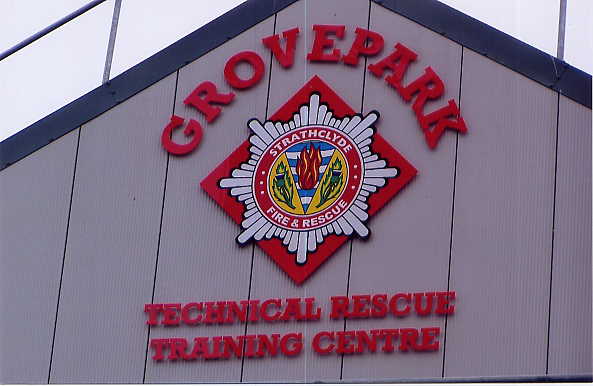

In 2005 work started on
converting the breathing apparatus training block and ladder workshop at
Hamilton Fire station into a dedicated Technical Rescue Training Centre. On this
site a grain silo, rope rescue tower and a concrete trench were also
constructed. The centre was needed as a result of 9/11, the London bombings and
also the Stockline Plastics factory explosion. Under the Fire (Scotland) Act
2005 Fire and Rescue services were given funding to attend non fire emergencies,
incidents which they had attended previously but were not given funding for, as
this was now part of their statutory requirements.
At this site Strathclyde firefighters will be trained in Road Traffic
Collisions, Trauma Management, Urban Search and Rescue, Rope Rescue, Confined
Space/Trench Rescue and Water Rescue which will be done off site.
The Technical Rescue Training Centre is under the command of a Group Commander
‘B’ with a Deputy who is a Group Commander ‘A’ and there are six Watch Commander
‘B’s, one for each of the sections:- RTC, Trauma, USAR, Rope Rescue, Confined
Space and Water Rescue.
The former BA building is where the USAR and Confined Space training is done.
The building has three interconnected concrete tunnels one of which is only half
a metre square. Concrete blocks can be slotted into the ends of the tunnels to
allow practice at breaking and breeching concrete barriers and the tunnels can
also be filled with rubble and to add realism plastic pipes are hidden in the
rubble and used to convey sounds of breathing, heartbeats, mobile phones,
watches ticking, moans and other signs of life which can be picked up by
sensitive listening devices. The centre also has flexible cameras and cameras on
long extending poles. This building also has a replica of a collapsed floor
which is hinged to the top of the staircase. An extension has been added at the
east end of the building, which is just three walls with no floors and this is
used for practicing shoring up of collapsed buildings and the wooden shoring on
the gable is straight out of the AFS drill book, still the best method of doing
it. On the roof of this flat roofed building a pitched roof has been built for
roof training. In the yard outside the building a pile of rubble has been dumped
complete with a sewer pipe.
Rope Rescue is done on a 25 metre high tower. This is a standard drill tower
built in modular form by Crofton Engineering of Cambridge so that when the TRTC
moves to its new (unknown at present) location in four years all they need to
build is the concrete base and dismantle the tower and then re erect it on the
new site. It has struts at the rear and a platform and canopy on the top. The
floor is in sections which can be lifted for practicing the raising and lowering
of casualties. The structure actually looks like a guard tower at a POW camp.
There is also a silo for combine rope/confined space rescue, which has a
platform built round the inside from which the instructors can supervise the
training. Firefighters can cut through the silo wall from outside or carry out a
rescue from above using lines and harnesses. There are also anchor bolts on the
roof of the USAR building for line rescue.
At the rear of the RTC block concrete trenches have been built at ground level
for trench rescue practice and the walls have been built up with earth into a
sort of mound so the trainees can stand above the trenches and look in.
The old Ladder store has been converted into classrooms where in the garage
section the trainees are shown the techniques of extrication with a rescue board
(this used to be called a spine board but that name was rather disturbing for
the casualty) before going outside to practice cutting up a car and extricating
the casualty. Also in this room line rescue techniques are taught before going
up the tower or silo. Another room has a manikin in it, that has adjustable,
pulse, heartbeat and breathing and here the trainees are trained in Trauma
Management to a level below Paramedics as all 115 front line appliances are to
get defibulators. There are a couple of lecture rooms with audio visual teaching
aids.
There are two 5.5 metre rescue boats at Port Glasgow Fire Station which are used
for Water Rescue training.
Vehicles
2007 SF06JYA Ford Ranger SEV (Away)
2009 SF09SOJ
Vauxhall Movano Van
GPV
2009 EU09AAF Ford Ranger
OSU (away to Clydesmill Station 2011)
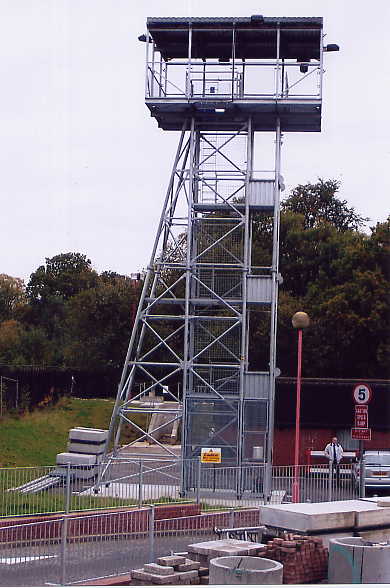
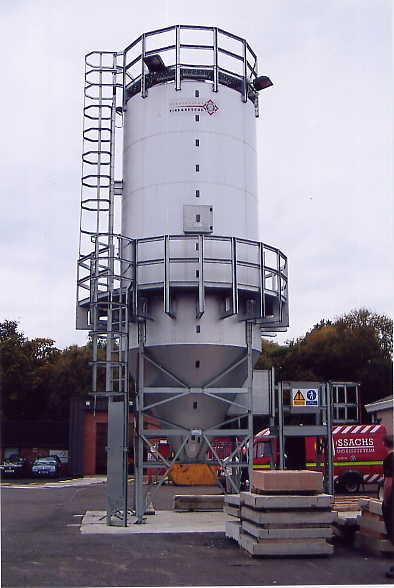
The Tower with concrete trench behind the struts. 100_8875 The grain silo 100_8876 20/10/2007
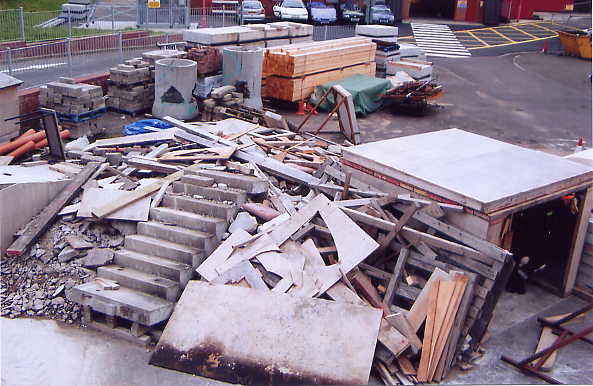
The rubble pile. 100_8877 20/10/2007
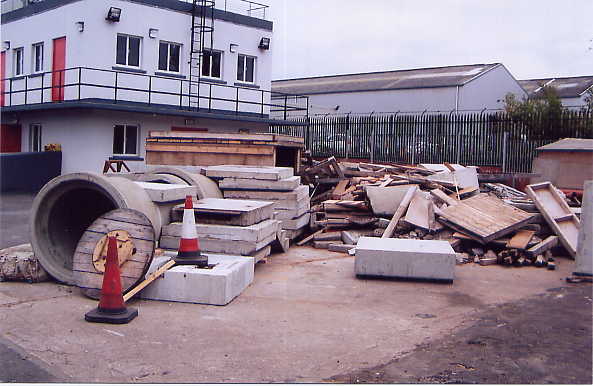
The rubble pile. 100_8880 20/10/2007
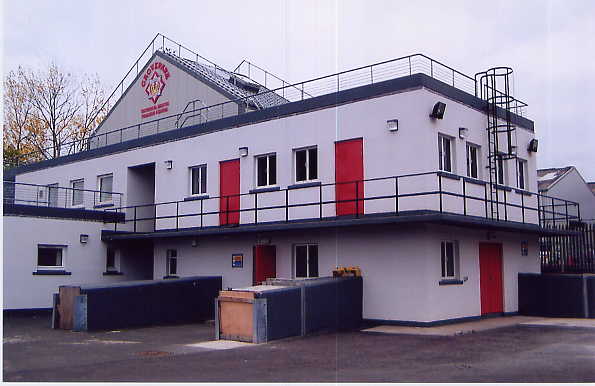
Grovepark the USAR building 100_8881 20/10/2007
Technical Rescue Training Centre
Strathclyde’s technical rescue centre is one of the most advanced in the UK
Strathclyde Fire and Rescue Service has designed and built a technical rescue
training centre (TRTC) to meet its requirements in relation to the Fire Service
(Scotland) Act, existing Health and Safety legislation and New
Dimension/resilience.
The TRTC
opened two years ago beside Strathclyde FRS headquarters in Hamilton, and
fulfils the following training needs:
• Urban search and rescue
• Road traffic collision
•Trench rescue
• Confined space rescue
• Rope rescue
• Trauma training
• Boat rescue.
The training
centre uses existing buildings with enterprising use of construction materials
and innovatively designed training rigs. The invaluable assistance of
instructional staff to develop the project with the full cooperation of SFR’s
management team, legal department, health and safety and property sections went
a long way to ensure the centre’s success.
Each of the training rigs has been designed and developed by individuals who
have a wealth of experience and skills in their specialist roles. Health and
safety controls have been engineered into each training rig as opposed to being
bolted on after construction, ensuring that the facility will continue to fulfil
its purpose for the foreseeable future without the requirement for additional
work.
The ‘Strategic Reserve’ strategy employed by SFR places a number of fire
appliances on a reduced state of readiness during periods of the day that have
been identified as low activity for emergency incidents, without depleting
emergency cover provided to the public. Four appliances along with their crews
attend the TRTC each day, enabling 20 firefighters to take part in high quality
risk critical training without removing them from their operational role.
In addition to strategic reserve-dedicated courses, all of the rescue elements
mentioned are carried out on a regular basis within the centre. All training
carried out focuses on casualty care with trauma training being a main priority
(First Person on Scene Intermediate level and First Aid at Work for support
staff). Power Boat training to an advanced level is conducted from an outreach
centre in the Clyde estuary. Senior Officer awareness courses are catered for
in-house, with the exception of boat training and USAR Sector Command carried
out at the mines rescue training facility in Fife.
The TRTC has
ten instructors, all highly trained in their own sphere of technical rescue with
teaching qualifications including:
• RTC I
• USAR trainer — basic tool skills
• USAR trainer —technician level
• USAR trainer — timber shoring
•Trench rescue—train the trainer
• Petrogen hot cutting
• Pre-hospital trauma life support (PHTLS)
• First aid at work (support staff)
• Confined space tunnel and shoring
• RYA principal (boat training coordinator).
Success and Credibility
The success and credibility of the TRTC not only lies
with the training rigs but the competence of the training staff to deliver
relevant and realistic training to its students. The methods of training
employed at the centre ensures that firefighters leave after attending a course
with an understanding of rescue techniques and the skills, knowledge, and
confidence in their own ability to safely carry out a specific task.
Since opening in January 2007, over 3,000 firefighters have passed through the
doors of the TRTC. This applies to wholetime and Retained Duty System
firefighters within Strathclyde Fire and Rescue Service.
In addition to their main teaching role, instructors from the USAR section are
on call to assist SFR Incident Investigation Research Section (IRIS) utilising
their skills in timber shoring, making areas safe and allowing evidence
gathering in places that previously may not have been accessible as a result of
dangerous conditions.
The TRTC actively encourages collaboration with all other fire and rescue
services in Scotland and other emergency services and agencies, such as The
Mines Rescue Service, Strathclyde Police, Isle of Man FRS and Trossachs Search
and Rescue Dog Team, creating a better working relationship through combined
realistic training.
Training will continue with a commitment to the people of Strathclyde, whether
resident or visitor, to provide a service at a level which they expect and
deserve and to deal with any incident involving the requirement for technical
rescue skills to assist in their safe recovery.
(FIRE magazine, January 2009. Page 38.)